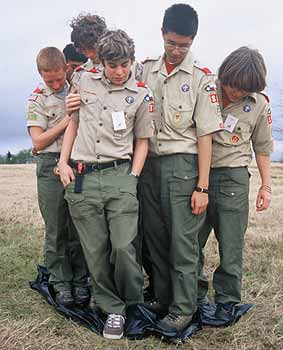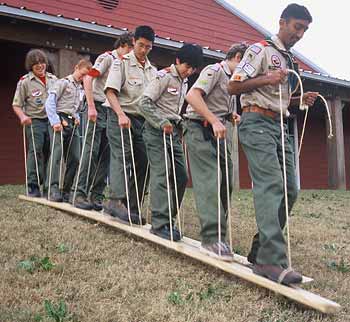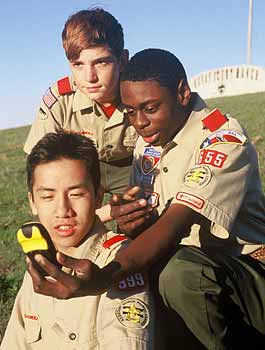A New Vision of Youth Leadership
By Robert Vernon
Photographs By David Nance
Revised council-level training will help prepare Scouts more than ever to provide important leadership to their troops.
 In a team-building test, the Red Patrol from one of four JLT troops attempts to reverse a tarp without any Scout losing contact with it. |
John Walker shook his head in amazement. As the Scoutmaster sat in a dusty barn watching the patrol members of his junior leader training (JLT) troop deliver their end-of-course presentation, he was convinced of one thing—"They got it."
"I've staffed four junior leader training courses, serving as Scoutmaster twice, and this is the first time I can truly say that the participants came away fully understanding the leadership skills they were taught," Walker said.
"Older boys, younger boys, even boys who weren't sure they wanted to be here, they all got it. That means a great deal to a troop leader like me, because the boys will return to their home troops from this council-level course better prepared to lead. And that's what this course is all about."
Walker was one of four Scoutmasters of training troops in the fourth pilot course using the new national junior leader training syllabus. Following pilot courses in 2003 at Louisville, Dallas, and Detroit, this final course, held in the Sam Houston Area Council, represented the biggest test for the new syllabus. Four JLT troops participated, with 204 Boy Scouts going through the six-day training.
 Red Patrol Scouts take on another challenge, walking in unison on parallel boards,. |
Selling an idea
"Junior leader training is the best way to sell Scouts on the idea of a boy-run troop," Walker said. "It sure makes a Scoutmaster's life easier when these young men can show the rest of their troop how to put the concept of boy leadership into action."
Staff members agreed that the content of the new syllabus was easy to work with and easy for young participants to understand.
"The material is easier to digest, and as the week goes along, it makes more and more sense because it builds on itself," said Spencer Gerondale, a JLT staff troop guide from Troop 455 in Houston. "These skills are very interconnected."
That was a goal for authors and designers of the new course.
Everyone agrees the previous JLT course helped thousands of young men and adults become solid leaders. But even its greatest supporters admit that it was tough to intellectually digest and apply.
"With the previous course, it was difficult for the boys to fully comprehend the 11 leadership skills—topics like communicating, knowing and using resources, controlling group performance, and sharing leadership," said John Alline, currently associate director for the BSA Jamboree Division.
 Staff troop guide Jonathan Sampson shows Trong Huynh and Adam Cauble how a GPS device works. |
Alline was on the national team that developed the new syllabus.
"Scouts and Scouters need to have the same basic leadership skills, knowledge, and understanding. The new material is designed to provide that basis," he said. "It is aligned to the core leadership fundamentals taught in Boy Scout Fast Start, New Leader Essentials, Scoutmaster's Specific Training, and in Wood Badge. The exciting part is that the material is delivered in an age-appropriate method."
Beginning in 2000, a group of about 40 Boy Scouts, Scout leaders, educators, corporate trainers, and representatives from military service academies began work on the new version.
"We have researched the techniques of some of today's top leadership authorities, and we've developed our own concepts," said Daniel Zaccara, BSA national chairman for junior leader training. "The result is a course that will offer Scouting youth the instruction needed to be outstanding leaders in the 21st century."
Leadership vision
Much of the course focuses on creating a vision of leadership and learning how to achieve that vision. The concept becomes clearer as the course progresses, crystallizing in the final two days.
"It took a while for some of the younger Scouts to grasp the concept of a 'vision,'" said Kyle Tipley, senior patrol leader of one of the four Houston JLT troops. "But eventually they started to see what it is and how it can work for them."
"The new course has received rave reviews," Alline said. "When it is implemented nationally in 2005, people will see how effective it is and easy for the boys to grasp."
Throughout the course, the participants are on a "Quest for the Meaning of Leadership"—an understanding of the concepts and skills being presented. Informed about the quest on the first day, each patrol must make a presentation at the end of the course detailing its understanding of the meaning of leadership.
Along the way, they are told how each leadership element fits into the quest.
"I'm going to paint you a picture of leadership," assistant Scoutmaster Mike Thompson tells the Scouts at the start of his lecture on Finding Your Vision.
"Each day we will add a little more paint, some different colors and hues, show you some different brush strokes, and in the end, you'll not only see a picture of leadership, but you'll know what it takes to create that picture, so you can take the lessons and techniques back to your troop and to your own personal life."
Using the 'compass'
In addition to the picture, the participants are given a metaphorical "compass" that can be applied to all course leadership elements.
For instance, there's the concept of team development. Scouts learn how groups, such as patrols, go through four stages of development—forming, storming, norming, and performing—in becoming a high-performing team.
These four stages form key quadrants of the "compass." Scouts are enlightened on how to recognize the stages and how to direct the team or patrol to the next stage.
"We had too many boys finish the previous course without being quite sure what they had learned," said David Boome, who was course adviser for the new JLT pilot in Louisville. "We now take the mystery out of it."
To do so, the new syllabus uses memory devices and repetition. For instance, SSC (start-stop-continue) replaces the harder-to-remember Thorns, Roses, and Buds, a staple of previous post-activity evaluation.
"I see how we'll use SSC in our own troop," said Life Scout Billy Gibula of Richmond, Tex. "When we start an activity, we can stop and see how it's going. If we need to change something, we can, then we'll continue. I see all kinds of applications for it."
SSC, along with several other memory mapping tools, is part of the alphabet soup of leadership skills the Scouts learn, use, and take home to their troops.
"This course has acronyms the boys can remember," said Jack Chandler, course adviser of the Detroit pilot. "Each step of the way, the previous skills are reinforced, and the participants are shown how each new skill interacts with the previous skills. By the end of the week, the boys can explain each skill and tell you how it is used. That's amazing."
Oath and Law
Throughout the course, choices are made, challenges met, and skills applied with the Scout Oath and Law serving as key elements to help the individual choose the appropriate path.
An example comes during the opening campfire, where the youth staff teaches the chief ingredients for a successful campfire. The staff carefully explains to the participants why certain skits, jokes, or songs are considered inappropriate because they do not adhere to the Scout Oath and Law.
"The program is very much aligned with the Scout Oath and Law," said William Hayter of Houston, who served as a senior patrol leader at the Houston course. "That theme is presented through-out the course, helping to drive home precisely how much impact [the Oath and Law] should have in the decisions we make in our lives."
The new syllabus also focuses on the importance of the relationship between the Scoutmaster and the senior patrol leader. These two individuals interact continually throughout the course, and that's by design. (See Sidebar) At the course's end, each patrol presents its findings on the "Quest for the Meaning of Leadership," using creative ways to review each skill and lesson learned during the week.
Some choose a skit format, others perform a recitation, and some even turn the lessons into song. Regardless of the form the patrols choose to complete their quest, they display a solid understanding of all they have learned.
And as they graduate from the course and head for home, one thing's for certain—there won't be any doubt that "they got it."
Freelance writer Robert Vernon lives in Dallas, Tex.
A Critical RelationshipAs Scoutmaster of one of the four troops at the Sam Houston Area Council's junior leader training (JLT) pilot course, Deb Grun met daily with senior patrol leader Keith Jones and made sure the rest of the troop was watching. Grun wanted the troop to be aware of how a Scoutmaster and senior patrol leader work together to deliver an effective program to the unit, reinforcing the concept that a troop is boy-led, but adult-directed. "We wanted to drive home how important that relationship is," Grun said. "There are units where the adults, even those with the highest level of training, tend to run the show," said Daniel Zaccara, BSA national chairman for junior leader training. "And there are troops where the Scoutmaster's presence is almost nonexistent. "That's why we want the Scoutmaster and senior patrol leader at JLT and at Wood Badge for the 21st Century to demonstrate the proper model. We want that message explained clearly, so there's no question about how the boy-led, adult-directed concept is supposed to function." — R.V. |
Local Traditions Can ContinueKeep the main ingredients, but flavor to taste.That's the guidance offered by the designers of the new junior leader training syllabus to the council staff who will implement the course. The new syllabus provides for retaining many of the traditions that have existed in each council's junior leader training program, such as spirit sticks, morning weather reports, songs, and decorative knots. Many councils' traditions include unique names for their course. For example, JLT is known as "Baden-Powell Camp" in Cincinnati's Dan Beard Council and as "Silver Pathfinder" in St. Paul's Indianhead Council. It's "Powderhorn" in the Milwaukee County Council and "Brownsea" in the Coronado Area Council in Salina, Kan. "We want council courses to continue those types of traditions, because they add to the flavor of the training," said John Alline, a member of the course development team. "What we don't want is tampering with the content, order, or timing of the course. The syllabus is designed to ensure a desired outcome. It's like a recipe—as long as you stick to the recipe, it's O.K. to add local flavor." "We have a strong tradition in our council with key elements we don't want to see diminished or abolished," said Doug Brown, Scoutmaster of one of the four troops at the Sam Houston Area Council course. In fact, Brown said, it is important for presenters to breathe life into the new material. "These are just words on paper," Brown told his staff during the Houston course. "You, as presenters and as a staff, are responsible for bringing your own fire, your own enthusiasm, and your own creativity, because that's what makes a course successful." In other words, feel free to spice it up. — R.V. |
Learning Leadership SkillsBSA junior leader training features instruction in skills that can be used at home, at school, on the job, and, in particular, at the Scout unit level. To be eligible, a Scout must be 13, a First Class Scout before the start of the course, and have his Scoutmaster's recommendation. That recommendation is significant, because the Scoutmaster can assess whether a young man is ready—emotionally, intellectually, and from a measure of maturity—for this training. The JLT course is a six-day training and camping experience, during which Scouts from throughout a council are placed in patrols that are part of a training troop. The course is directed by a staff of junior leaders and instructors who work closely with their adult advisers. Scouts and their patrols get an opportunity to practice and experience leadership skills firsthand. Scouts who have completed a junior leader training course return to their troops with a toolbox of leadership skills that enables them to better understand their role as someone who can and should shape the direction of his troop. "Each Scout returns home knowing not only how the troop functions, but why," said John Walker, a Scoutmaster at the Houston pilot course. "He is better equipped to communicate with boys and adults, to plan, to help the troop function as a high-performance unit." Qualified Scouts from local councils can attend a National Junior Leader Instructor Camp at the Philmont Training Center in New Mexico, where they learn the teaching skills necessary to serve as staff members on their council-level courses. — R.V. |
'Be-Know-Do'The "Be-Know-Do" element is a slogan of the new junior leader training course. On the first day, the senior patrol leader explains that, as patrol members and staff make their way through the course, they will explore: • The BE of leadership, which includes finding your vision, setting goals, making ethical decisions, leading yourself, and leading others. • The KNOW of leadership, which encompasses the skills of teaching and leading to help groups achieve their goals. • The DO of leadership, which is represented by a toolbox of skills and methods for communicating effectively, solving problems, and resolving conflicts. Or as Jason Fochtman, senior patrol leader of one of four troops in the Houston pilot course, said in summarizing the concept: "Before you can lead others, you have to be able to lead yourself." — R.V. |
October 2004 Table of Contents
Copyright © 2004 by the Boy Scouts of America. All rights thereunder reserved; anything appearing in Scouting magazine or on its Web site may not be reprinted either wholly or in part without written permission. Because of freedom given authors, opinions may not reflect official concurrence.